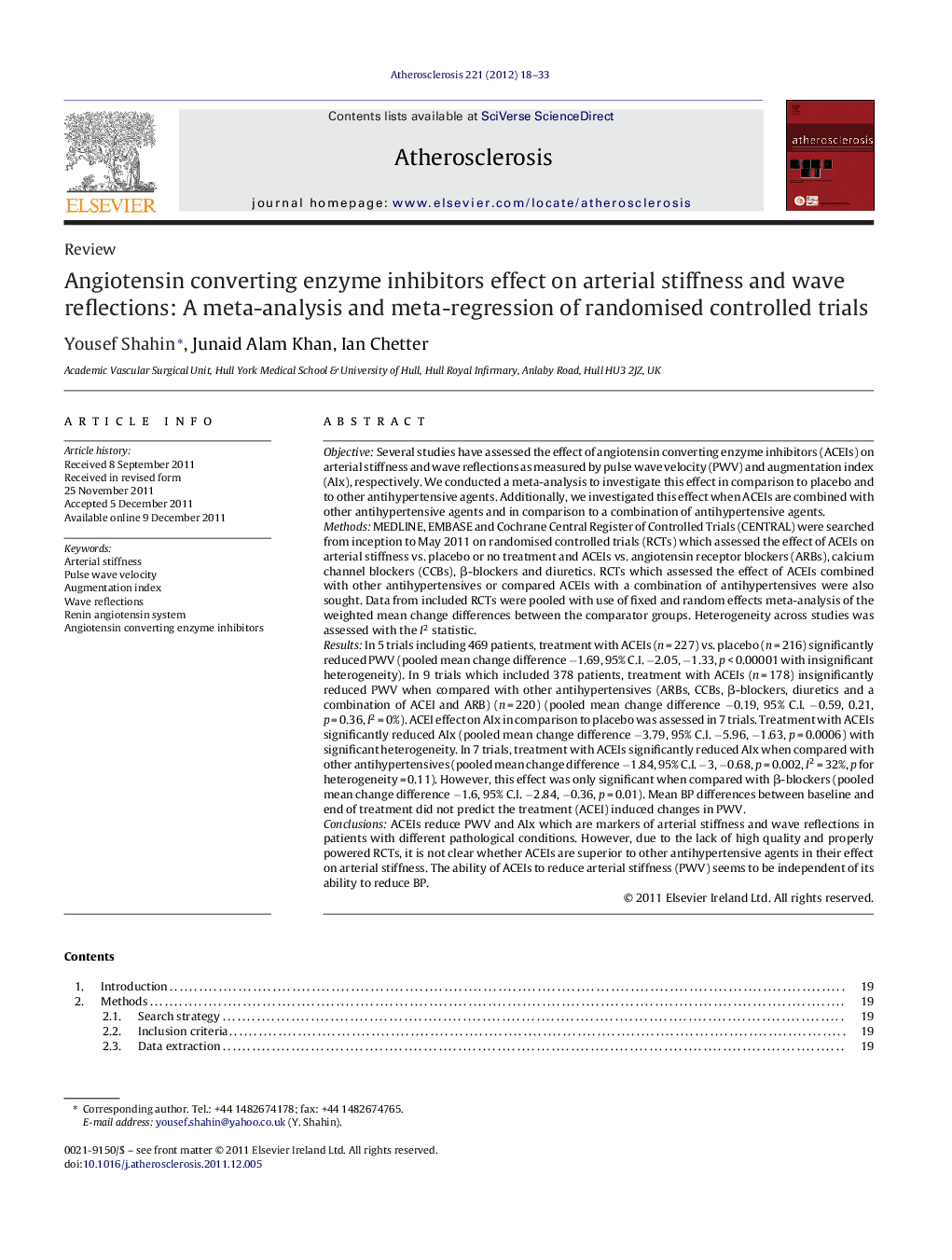| کد مقاله | کد نشریه | سال انتشار | مقاله انگلیسی | نسخه تمام متن |
|---|---|---|---|---|
| 5948901 | 1172384 | 2012 | 16 صفحه PDF | دانلود رایگان |

ObjectiveSeveral studies have assessed the effect of angiotensin converting enzyme inhibitors (ACEIs) on arterial stiffness and wave reflections as measured by pulse wave velocity (PWV) and augmentation index (AIx), respectively. We conducted a meta-analysis to investigate this effect in comparison to placebo and to other antihypertensive agents. Additionally, we investigated this effect when ACEIs are combined with other antihypertensive agents and in comparison to a combination of antihypertensive agents.MethodsMEDLINE, EMBASE and Cochrane Central Register of Controlled Trials (CENTRAL) were searched from inception to May 2011 on randomised controlled trials (RCTs) which assessed the effect of ACEIs on arterial stiffness vs. placebo or no treatment and ACEIs vs. angiotensin receptor blockers (ARBs), calcium channel blockers (CCBs), β-blockers and diuretics. RCTs which assessed the effect of ACEIs combined with other antihypertensives or compared ACEIs with a combination of antihypertensives were also sought. Data from included RCTs were pooled with use of fixed and random effects meta-analysis of the weighted mean change differences between the comparator groups. Heterogeneity across studies was assessed with the I2 statistic.ResultsIn 5 trials including 469 patients, treatment with ACEIs (n = 227) vs. placebo (n = 216) significantly reduced PWV (pooled mean change difference â1.69, 95% C.I. â2.05, â1.33, p < 0.00001 with insignificant heterogeneity). In 9 trials which included 378 patients, treatment with ACEIs (n = 178) insignificantly reduced PWV when compared with other antihypertensives (ARBs, CCBs, β-blockers, diuretics and a combination of ACEI and ARB) (n = 220) (pooled mean change difference â0.19, 95% C.I. â0.59, 0.21, p = 0.36, I2 = 0%). ACEI effect on AIx in comparison to placebo was assessed in 7 trials. Treatment with ACEIs significantly reduced AIx (pooled mean change difference â3.79, 95% C.I. â5.96, â1.63, p = 0.0006) with significant heterogeneity. In 7 trials, treatment with ACEIs significantly reduced AIx when compared with other antihypertensives (pooled mean change difference â1.84, 95% C.I. â3, â0.68, p = 0.002, I2 = 32%, p for heterogeneity = 0.11). However, this effect was only significant when compared with β-blockers (pooled mean change difference â1.6, 95% C.I. â2.84, â0.36, p = 0.01). Mean BP differences between baseline and end of treatment did not predict the treatment (ACEI) induced changes in PWV.ConclusionsACEIs reduce PWV and AIx which are markers of arterial stiffness and wave reflections in patients with different pathological conditions. However, due to the lack of high quality and properly powered RCTs, it is not clear whether ACEIs are superior to other antihypertensive agents in their effect on arterial stiffness. The ability of ACEIs to reduce arterial stiffness (PWV) seems to be independent of its ability to reduce BP.
Journal: Atherosclerosis - Volume 221, Issue 1, March 2012, Pages 18-33